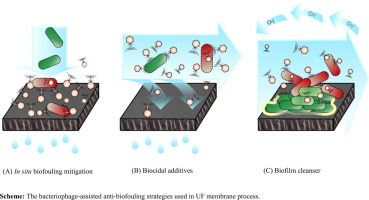Journal of Colloid and Interface Science ( IF 9.4 ) Pub Date : 2018-03-30 , DOI: 10.1016/j.jcis.2018.03.105 Wen Ma , Magdalena Panecka , Nathalie Tufenkji , Md. Saifur Rahaman

|
The ability of bacteriophages to infect and destroy specific bacteria makes them promising antimicrobial agents in industrial processes. In this study, potential strategies of bacteriophage-facilitated biofouling control during membrane ultrafiltration (UF) were investigated through use of the model T4 bacteriophage and the model host bacterium, Escherichia coli. In the dead-end filtration mode, phages were immobilized on the membrane surface to serve as biocidal agents and inhibit the propagation of bacteria in situ. After 6 h of filtration, a 36% flux reduction was observed for the T4-functionalized membrane in comparison to 71% for the non-functionalized membrane. Surface modification of the membrane using O2 plasma treatment resulted in increased numbers of bound phage and enhanced biofouling resistance of the membrane. Introducing the phage into the feed of a cross-flow filtration system effectively mitigated the water flux reduction of the membrane caused by bacterial growth. By modifying the concentration of phage additives, the growth of bacteria was delayed, inhibited, or eliminated. Phage treatment changed the structure of biofilms on the membrane surface and facilitated in situ biofilm cleaning. A 20% greater recovery in water flux was observed for the biofilm-contaminated membrane following phage-assisted cleaning when compared to the membrane cleaned via a physical washing process. Taken together, these results show that bacteriophage assisted anti-biofouling strategies have the potential to mitigate biofouling in membrane processes in an environmentally friendly manner.
中文翻译:

基于细菌噬菌体的超滤生物污损控制策略:原位生物污损缓解,杀生物添加剂和生物膜清洁剂
噬菌体感染和破坏特定细菌的能力使其成为工业过程中很有希望的抗菌剂。在这项研究中,通过使用模型T4噬菌体和模型宿主细菌大肠杆菌研究了膜超滤(UF)期间噬菌体促进生物结垢控制的潜在策略。在死端过滤模式下,噬菌体被固定在膜表面上以充当杀菌剂并抑制细菌原位繁殖。过滤6小时后,观察到T4官能化膜的通量减少了36%,而未官能化膜的通量减少了71%。使用O 2对膜进行表面改性等离子体处理导致结合的噬菌体数目增加和膜的抗生物结垢性增强。将噬菌体引入错流过滤系统的进料中可有效减轻细菌繁殖引起的膜水通量减少。通过改变噬菌体添加剂的浓度,细菌的生长被延迟,抑制或消除。噬菌体处理改变了膜表面生物膜的结构并促进了原位生物膜清洁。与通过物理洗涤方法清洁的膜相比,在噬菌体辅助清洁后,被生物膜污染的膜的水通量回收率提高了20%。综上所述,这些结果表明,噬菌体辅助的抗生物结垢策略具有以环境友好的方式减轻膜工艺中生物结垢的潜力。















































 京公网安备 11010802027423号
京公网安备 11010802027423号